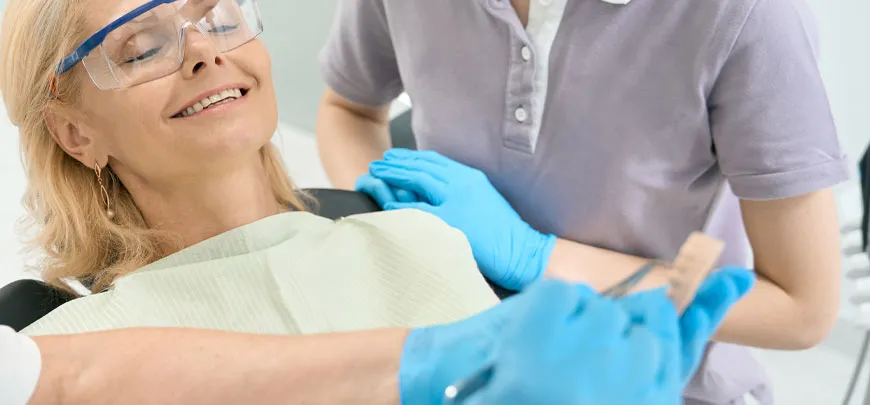Working Hours
- Mon-Thu 9 AM - 6 PM
Fri and Sat 9 AM - 3 PM
Sun Closed
Contact Info
-
Phone: 514-695-5545
- dentalolympic@gmail.com
Periodontics

Does gingivitis sound familiar to you? This well-known condition just happens to be the periodontal disease most commonly treated by periodontists. When gums and bone tissues are infected with bacteria and their vitality is threatened, it is important to consult a periodontist who will suggest treatments suited to your dental needs.
Prevention, diagnosis, and treatment of periodontal disease
Beyond aesthetics, treating periodontitis eliminates harmful bacteria and stimulates bone and gum tissue regeneration.
At Centre Dentaire Olympique, we are proud to deliver the highest quality care and treat your periodontal disorders with cutting-edge technology.
Conditions most frequently treated by periodontists:
Gingivitis:
Mild to moderate periodontitis:
Advanced periodontitis:
Missing teeth:
A mild inflammation of the gums that may or may not be cause pain and bleeding.
Moderate periodontitis (gum disease) is diagnosed when the pockets between the teeth and soft tissues run 4 to 6 mm deep.
Advanced periodontitis is diagnosed when the pockets between the teeth and soft tissues run deeper than 6 mm and significant bone loss has occurred, causing displacement and tooth loss.
When teeth are missing due to bone loss, the periodontist may use dental implants to replace them.
Here are some common periodontal treatments:
Gingivoplasty (reshaping of gum tissue):
Bone graft:
Deep pocket cleaning:
Crown lengthening:
Tooth mobility caused by periodontitis can make the teeth seem much longer due to lack of gum tissue. The periodontist can correct this problem with a gum graft that makes the smile symmetrical.
To put dental implants in place, the jawbone must be sufficiently dense and stable to hold the prosthesis. Bone grafting may be necessary to reinforce the jawbone.
The progression of gingivitis and periodontitis makes it more difficult to clean the pockets between soft tissues and teeth. The periodontist can de-scale the teeth and plane the roots (sometimes under local anaesthesia) to remove bacteria and debris causing the infection.
If you’re embarrassed to smile due to too much gum tissue, crown lengthening can restore your attractive smile.
BOST periodontal treatment
Is periodontitis curable?
What is periodontitis and how to fight it? Are there any treatments for periodontitis that can prevent bleeding gums, bad breath and loss of teeth? Periodontitis is a tissue disease that surrounds a tooth: gum, ligaments that attach the tooth to the bone, and the bone itself. Those who have faced such a problem got used to its persistency and probably were told that periodontitis is not curable, and that its development can only be slowed down or, under certain conditions, suspended for some time. Some believe that the disease is hereditary, others believe that they are bound to lose their teeth. Is this really the case, and what can modern medicine offer us?
Factors that affect the development of gum disease
Indeed, there are many factors that affect the development of gum disease and tissues surrounding the tooth, including heredity. But there is one factor without which periodontitis cannot develop – is the presence of pathogens.
Unfortunately, where there is a breeding ground for these organisms, they will definitely settle there. Starting from the first teeth erupting there are potential conditions for the development of the disease. None of us live under the hood in the laboratory, the microorganisms are quite easily transmitted by personal contacts. In case of poor hygiene (the concept is individual for each person), plaque accumulates on teeth, which consists of several types of microorganisms. With a certain amount of them (also individually for each person), the body begins to resist. The cells of the immune system of the mouth begin to attack foreign bacteria. This is how gum inflammation develops, which can be accompanied by bleeding and bad breath.
These symptoms are not always obvious. Usually, patients rarely see a doctor at this stage, and after a couple of months, deep tissues such as the tooth ligament and bone are getting involved. At this stage we are already talking about periodontitis.
How is periodontitis fundamentally different from gingivitis?
As soon as the ligaments of the tooth start to dissolve , they form, so-called, periodontal pockets. This is a very important point. Where the depth of the pockets reaches 4 mm or more, the microflora changes to a more aggressive one. In such pockets oxygen-free ( or anaerobic) condition is created, which is a good environment for the development of particularly aggressive anaerobic microorganisms. By releasing toxins, such bacteria dissolve ligaments and bone at an even higher rate. At the end, this will lead to loosening and losing of teeth.
Unfortunately, it is impossible to cure periodontitis by yourself with home remedies, antibiotic therapy or mouthwash fluids. Of course, good hygiene and visits to a dental hygienist to remove dental plaque and deep cleaning (curettage) reduce the rate of disease, but cannot completely stop it. Yes, it is possible to reduce the number of microorganisms for some time, and to reduce the symptoms of the disease. But problematic deep periodontal pockets remain. Where oxygen will not be available, there will be the possibility of recurrent infection.
There are several methods of periodontal tissue treatment: surgical and non-surgical. The disadvantage of most non-surgical methods is that they are not able to reduce the depths of the pockets. The radical traditional method in this case is flap surgery. During the operation, the gums are excised (shortened). This method allows to get rid of periodontal pockets (by cutting them), but it can be very painful and unsightly. As a consequence, the root of the teeth is often exposed which can cause sensitivity.



